
Original Link: https://www.anandtech.com/show/1399
Intel's 90nm Pentium M 755: Dothan Investigated
by Anand Lal Shimpi on July 21, 2004 12:05 AM EST- Posted in
- CPUs
Sixteen months ago, Intel released a confusing little thing called Centrino; it wasn't a new processor or chipset, but rather a "technology". Intel pumped billions into the marketing of this technology and even to this day, we still see the same "What is Centrino?" question. But unlike most multi-billion dollar marketing campaigns, Centrino wasn't a hip name masking uninteresting technology; instead, Centrino encompassed one of the most impressive microprocessor architectures to ever come out of Intel: Banias.
We had all heard about Banias, which was officially named the Pentium M, for almost two years, but most shrugged it off as a rebranded Pentium III. With the Pentium 4's power requirements climbing, it was all too easy to believe that Intel would just go back to a much cooler running architecture for the future of their mobile processors. Pentium M became known as a Pentium III with the Pentium 4's Front Side Bus long before it ever shipped, before the first benchmarks were ever run. But as we just finished mentioning, this processor was far from rehashed technology.
Last year, we took an in-depth look at the Pentium M and came away from the experience extremely pleased. Our sentiments were echoed by manufacturers and end users alike, with the Pentium M and Centrino notebooks that use the processor selling extremely well and truly enabling high performance, long battery life, thin and light notebooks. Offerings like IBM's Thinkpad X series grew extremely popular among business users while more stylistic options, like the Sony VAIO X series, brought a new meaning to portable, with Pentium M designs weighing less than 1.8lbs. What Pentium M brought Intel was the portability and form factor advantages of Transmeta, with the performance that Intel customers were used to.
To put it bluntly, Intel's Pentium M was an instant success and well deserving of the success at that. But in our long running history at AnandTech, we've never been quite satisfied with one successful product - we want to see improvements, perfection of the perfect, if you will. And thus, it was no surprise that we were quite eager to take a look at the follow-up to Intel's 0.13-micron Pentium M, code-named Dothan.
We first heard about Dothan before Banias ever hit the streets as Pentium M. If you'll remember from our original article on the Pentium M, Banias only missed its target completion date by a matter of days. One by-product of on-time execution was that a number of architectural tweaks that the design team wanted to get into Banias had to be left out, a sacrifice made to preserve on-time execution. As soon as the Banias design was complete, those final architectural tweaks and enhancements that didn't make it into the first Pentium M incarnation were at the top of the list for its successor. As a result, Dothan is best viewed as a more polished evolution of Banias, with higher clocks and more cache made possible by Intel's 90nm process.
But unlike Banias, Dothan wasn't the perfect student on time to its launch; instead, Dothan was released after months of delays. Intel has already publicly released the reason for Dothan's delay. There was apparently an analog design issue with Dothan; more specifically, a PLL was too jittery. Dothan was actually in the hands of OEMs back in January, but the yields were extremely low, thanks to the jittery PLL issue. The solution to the problem required another spin of the silicon, which takes a long time (even longer at 90nm) and resulted in Dothan's lengthy delay.
Being an evolutionary, rather than revolutionary part, Dothan isn't nearly as exciting to talk about as Banias was, but as you'll soon see, that doesn't take away from its worthiness of carrying the Pentium M name.
A quick look back at Banias
The core technologies of the Pentium M remain unchanged in Dothan. We've already explained them in great detail but here's a quick recap for those of you who haven't read or don't remember the original article.The Pentium M is characterized by the following 7 design features and principles:
Mid-Length pipeline
The Pentium M has a pipeline that's shorter than that of the Pentium 4 (much shorter than that of Prescott), but longer than that of the Pentium III. Intel needed a longer pipeline to ensure that higher clock speeds would be possible, but shunned the Pentium 4's extremely long pipeline as it is quite a power hog. Although extremely high clock speeds can be wonderful for performance and marketing, they are a nightmare when it comes to power consumption. The longer your pipeline, the harder you have to work to keep that pipeline filled at all times and the bigger the penalty that you pay if the pipeline is ever left idle or has to be flushed (thanks to a mispredicted branch, for example).To this day, Intel has still not disclosed the number of stages in the Pentium M pipeline out of an extreme desire to protect the processor's underlying architecture. The only thing we know is that Dothan's pipeline remains unchanged from Banias; a very good thing considering the surprise we all got with Prescott .
Much of Banias (and also Dothan) remains unpatented and protected using trade secret law in order to prevent the underlying ideas behind the CPUs' design from being picked up by competitors.
Micro Ops Fusion
The Pentium M, like all of Intel's modern day microprocessors, decodes regular x86 instructions into smaller micro-ops that are the actual operations sent down the pipeline for execution. Micro Ops Fusion takes certain micro-ops and "fuses" them together so that they are sent down the pipeline together and are either executed in parallel or serially without being reordered (or separated from one another). Micro Ops Fusion can only apply to certain types of instructions, which Intel has not officially disclosed.The benefits of Micro Ops Fusion are multi-faceted; first, you have the obvious performance improvements, but alongside them, you also have reduced power consumption, thanks to not wasting any cycles waiting for dependent micro ops to retire before working on others.
Dedicated Stack Manager
Banias' dedicated stack manager is another power saving tool integrated into the Banias architecture that is designed to manage stack pointers and other stack-related data. Remember that stacks are used to store information about the current state of the CPU, including data that cannot be kept in registers due to limits in the number of available registers; thus, a dedicated manager can help performance considerably. As usual, whenever efficiency is improved, power consumption is optimized, which is the case with Banias here as well.High Performance Branch Predictor
Banias' branch predictor reduced mispredicted branches by around 20% when compared to the Pentium III (when running SPEC CPU 2000 tests, but the improvements are very real world). The improvements are thanks to a larger branch history table (for storing data used to predict branches) and better handling of branching in loops, the latter of which is improved in Dothan.Pentium 4 FSB, Pentium III Execution Units
The execution back end of Banias is identical to that of the Pentium III, making the Pentium M a relatively narrow microprocessor when compared to AMD's Athlon 64 and Intel's Pentium 4. Given the low power target for Banias, this decision makes a lot of sense as it reduces power consumption and die size; but keep in mind that the lack of extreme width in the pipeline means that technologies like Hyper Threading will be kept away from the Pentium M. Instead, we can look forward to having multi-core Pentium M designs, which is made somewhat easier to implement, thanks to a relatively small die.In order to keep the processor fed, however, Intel implemented the Pentium 4's 64-bit quad-pumped front side bus. Currently, the FSB clock on all Banias (and Dothan) parts is 100MHz quad-pumped (effectively, 400MHz for 3.2GB/s of bandwidth), but by the end of this year, it will move to 133MHz (effectively 533MHz).
Power Saving Cache
Banias (and Dothan) implement an 8-way set associative L2 cache, which is not uncommon amongst modern day microprocessors. A set associative cache increases hit rate (likelihood that something you want will be found in cache) at the expense of increased cache latency. Cache latency is increased because once the location of data is found in cache, in which "way" it exists must be determined and selected - an incorrect determination will further increase cache latency.In order to optimize the 8-way set associative cache for low power consumption, each "way" is further divided into quadrants. Once a "way" is selected, the L2 controller will determine in which quadrant the needed data resides and only activates that part of the cache. With such a large cache, it is important to save power here as much as possible.
Artificially Limited Clock Speed Design
Generally speaking, when you design a microprocessor, you want it to run as fast as possible. Normally, there's an initial idea of target clock speed and once the chip is actually back from the plant, it's not uncommon to find parts of the chip that run slower than your clock target, while others run faster (sometimes much faster). In desktop microprocessor design, the goal is to speed up the slowest parts of the chip (or critical paths as they are known among chip designers) and tweak the chip and the manufacturing process to run as fast as the fastest parts.With Banias, Intel took a different approach. The design team set a clock speed target, and if any part of the chip exceeded that clock speed target, then that part of the chip had to be slowed down. The idea was that if a chip can run faster than its target, then you're wasting power - a luxury that isn't present in mobile chip design. The upside to this design methodology is that power consumption is further reduced, and when coupled with the other power-saving advancements that we've talked about, we're dealing with a fairly low power chip. The downside is that each generation of the Pentium M has a very well defined clock speed wall, and the only way over that wall is to use a smaller, cooler and faster manufacturing process. This is why you will see Pentium M ramp much slower in clock speed than any other Intel chip and why you will see clock speed bumps coincide with new manufacturing processes. It also means that if Intel ever has yield problems with a new manufacturing process (which isn't uncommon), the Pentium M will suffer. It's a risky move, but it's the type of move that is necessary to truly build a good mobile CPU.
The 5 Things that Comprise Dothan
There are five basic parts of Dothan that differ it from Banias, but unfortunately (just as was the case with Banias), Intel is not very forthcoming with details about Dothan out of a desire to guard their intellectual property. Even a year after its release, we have yet to see any serious competition for the Pentium M and Intel wants it to remain that way for as long as possible.That being said, we will try to be as specific about the details of Dothan as much as possible; and we'll start at the most obvious - its 90nm process.
90nm process and 2MB L2
Banias was built on Intel's 0.13-micron manufacturing process at its peak. The tried and true manufacturing process meant that Banias faced no manufacturing delays and could hit its target clock speeds without a problem.Dothan gets its most noticeable improvements over Banias, thanks to the move to Intel's smaller 90nm manufacturing process. This is the same process that's used in the manufacturing of Prescott, which means a couple of things. For starters, it explains why availability of Dothan hasn't been incredible, since its launch as 90nm production is still ramping. The availability problem aside, 90nm gives Dothan the ability to cram almost twice as many transistors onto the chip without increasing the overall die size compared to Banias.
Dothan is now a 140 million transistor chip (up from 77 million in Banias) with those 140 million transistors occupying the same 84 mm2 die area as Banias (almost, Banias is about 1 mm^2 smaller). Almost twice the transistors with no increase in die size? It's a chip manufacturer's dream. Because of the stagnant die size, yields should not differ between Banias and Dothan (once Intel's 90nm process has truly matured) and it shouldn't cost Intel any more to produce Dothan than it did Banias.
The majority of the increase in transistor count is thanks to Dothan's 2MB L2 cache, twice that of Banias' 1MB cache. The 64KB L1 cache remains the same that was present in Banias.
We believe that Intel is using the same 90nm SRAM cells from Prescott in Dothan. If they are indeed, then the extremely small 84 mm2 die is further enabled by the significantly smaller 90nm SRAM cells that Intel developed. However, we are not clear as to how independent Banias and Dothan's SRAM cell design remains from the desktop chips, thanks to their unique power requirements.
Along with a larger L2 cache, Intel has increased how aggressively Dothan prefetches data into its cache in order to take advantage of the extra on-die L2. This is a fairly normal practice that microprocessor designers employ whenever an architecture stays the same, but cache size increases in order to help improve performance.
The 90nm process will also allow Dothan to scale up in clock speed, thanks in part to Intel's strained silicon technology, something that we're already seeing the fruits of today with its introductory 2GHz clock speed (up from Banias' 1.6GHz intro speed). Dothan will break the 2GHz barrier by the end of 2004. Remember that Intel's design philosophy with Dothan, just like Banias, is to design the chip for a specific power consumption and to leave clock speed scaling mostly up to the manufacturing process to enable.
Dothan's 90nm manufacturing process, in the end, gives it the higher clock speeds and larger L2 cache, which offer some of the more tangible advantages over Banias. Another very important fact to keep in mind is that these are the only major changes to Banias that make up Dothan; unlike Prescott, the pipeline has not been changed at all. Even Intel's Dothan design team views Prescott as a bit of a risky move, to try out significant modifications to the architecture alongside a brand new manufacturing process. Thus, it's no surprise that Dothan remains relatively unchanged architecturally outside of the move to 90nm; the pipeline and L1 cache are identical to Banias.
Micro Ops Fusion
Intel has been deliberately vague about Banias' micro ops fusion and they continue to be such with the modifications to the micro ops fusion engine in Dothan. All that we are allowed to publish is that Dothan now allows more types of micro ops to be fused, which isn't a bad thing, it would just be nice to know which ones and what enables Dothan to support the fusing of more micro ops.Local Branch Prediction Improvements
With Dothan, there have been some improvements to branch prediction performance in order to reduce power consumption and increase performance. Remember that the fewer branch mispredicts you have, the less power that is wasted on refilling the pipeline after a flush.One of the biggest improvements to Dothan's branch predictors is in its loop detector. Although most don't think of a loop as a branch, all loops either end or begin with some sort of a comparison statement that determines whether the loop should continue to execute (e.g. if i ‹ 10, then keep looping). Loops are normally handled by a static branch predictor that always predicts taken once a loop is detected, and usually the only mispredicts that exist once a loop is detected are at the end of the loop. While this works fine for larger loops (100+ iterations), it does not work so well for extremely small loops (e.g. 5 iterations). What ends up happening is that the 5th, 6th and 7th time around, the predictor will mispredict a taken branch when, actually, the loop is finished with. Mispredicting 3 times for a loop that only runs for 5 iterations does not help branch prediction accuracy, so we have a problem on our hands.
Dothan includes a more sophisticated algorithm in its detection and prediction of branches involving small loops; once again, Intel was purposely vague about exactly what Dothan does that Banias did not, but just know that Dothan has better overall branch predictor performance, thanks to modifications like improved detection of short loops.
Faster Integer Division
When moving to a small manufacturing process, it's often possible to include logic that didn't make the cut originally due to space constraints, such is the case with Dothan and its integer division performance. Once again, all we know is that integer division is faster on Dothan, but no idea how fast or why.Enhanced Register Access Mananger
As we mentioned at the beginning of this article, much of what went into Dothan were tweaks to Banias that couldn't be implemented without pushing the design completion date further out. One such fix that didn't make it to Banias was a workaround to a register access issue that caused the entire pipeline to stall in Banias. The situation was a unique one, where a partial register write followed by a full register read would cause the pipeline to stall. Dothan features a workaround for the problem and there is no longer a performance penalty for performing a partial register access followed by a full register access.The Pentium M Socket
There's a bit of confusion regarding the Pentium M's compatibility with desktop Pentium 4 motherboards. Remember that although the Pentium M is electrically compatibile with the Pentium 4's FSB, it is not pin compatible with the Pentium 4.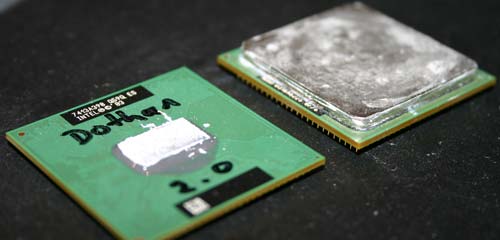
The Pentium M CPU has the same number of pins as a Pentium 4. However, the pinout is completely different, meaning that what's actually carried on those 478 pins is not the same between the two chips.
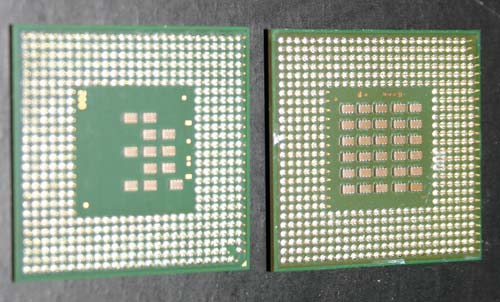
Intel went one step further and changed the location of the keying pins to make sure that you could not physically install a Pentium M CPU into a Pentium 4 motherboard.
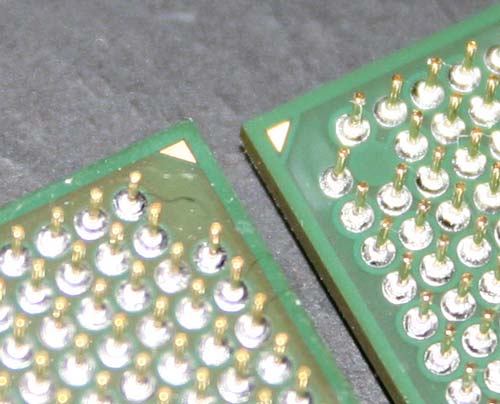
The Pentium M on the right is keyed differently than the Pentium 4 on the left. Thus, you can't put a Pentium M into a Pentium 4 socket, mobile or desktop.
That being said, there's nothing stopping a motherboard manufacturer from producing a desktop motherboard that supports the Pentium M processor - because once again, the Pentium M is electrically compatible with the Pentium 4 and should thus work with any desktop Pentium 4 chipset.
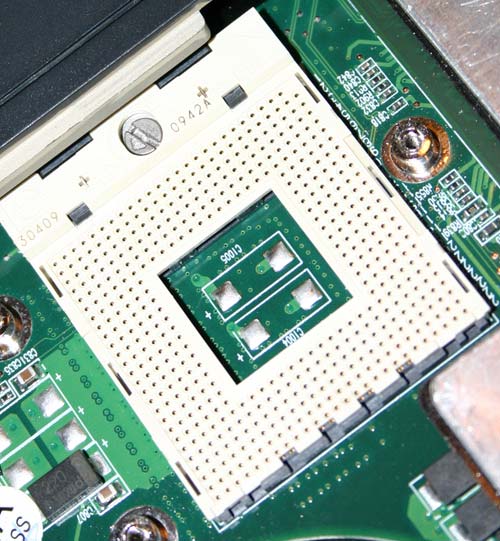
Dothan's Model Numbers
Intel started their model numbering system with Dothan's launch. For those of you who are confused by the "helpful" system, here is a table to tell you at what clock speeds the various processors are really running:| Core | Clock Speed | Thermal Design Power | |
| Intel Pentium M 755 | Dothan | 2.0GHz | 21W |
| Intel Pentium M 745 | Dothan | 1.8GHz | 21W |
| Intel Pentium M 735 | Dothan | 1.7GHz | 21W |
| Intel Pentium M 733 | Dothan Ultra Low Volt | 1.1GHz | 5W |
| Intel Pentium M 725 | Dothan | 1.6GHz | 21W |
| Intel Pentium M 723 | Dothan Ultra Low Volt | 1.0GHz | 5W |
| Intel Pentium M 715 | Dothan | 1.5GHz | 21W |
| Intel Pentium M 713 | Banias Ultra Low Volt | 1.1GHz | 7W |
| Intel Pentium M 705 | Banias | 1.5GHz | 24.5W |
For the most part, a higher number means a faster processor when it comes to the Pentium M, but there are a few exceptions.
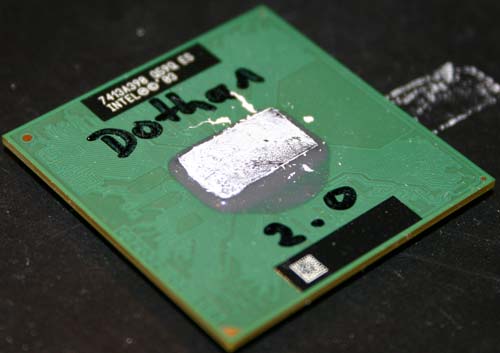
First of all, the 715, 725, 735 and 745 all have one thing in common - for every 10-point increase in model number, there is a 100MHz increase in clock speed. The 755 is the only exception, which has a 10-point increase in model number for a 200MHz increase in clock speed.
The 705 runs at the same speed as the 715, but it uses the older Banias core - so that's a chip that you'll want to stay away from as it offers lower performance and is more power hungry.
The Ultra Low Voltage Dothans run at 1 - 1.1GHz, but have model numbers close to that of the 1.6GHz and 1.7GHz Dothans. Although they consume far less power, keep in mind that they will not perform similarly to the 725 and 735 processors. Then again, these chips are normally found in ultra portable notebooks that wouldn't offer normal Pentium M chips, so it's not usually a decision that you'll have to face. If you want an ultra portable, you'll have to put up with lower clocked processors.
Looking at the TDP values, you see that clock for clock, Banias consumes more power than Dothan, making Dothan better for performance and battery life. For those who look at Prescott as an example of how "bad" Intel's 90nm process is, take a look at Dothan as a more accurate measurement. Without any architectural changes, 90nm allows Dothan to run cooler and faster - the opposite of what we've seen on Prescott, leading us to believe that the reason for Prescott's heat issues isn't Intel's 90nm process, but rather the architectural changes to Prescott.
The Test
For this test, we used a Winbook W360: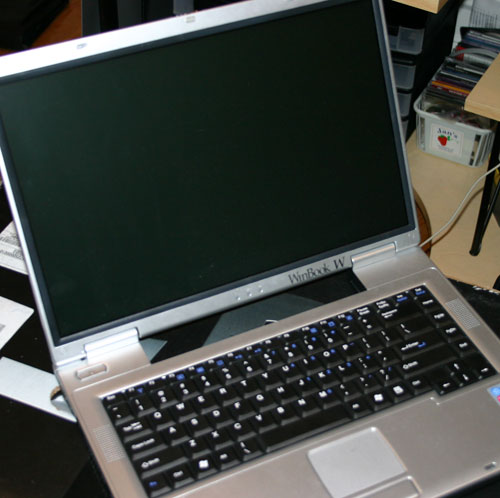
For all of our Pentium M (Banias and Dothan) and Celeron M tests, we used the Winbook W360 as our test platform.
However, for our Athlon 64 and Pentium 4 tests, we had to use desktop platforms configured to the specifications of the Winbook W360 in order to produce comparable numbers. Thus, we used a laptop hard drive (IBM Travelstar 5400RPM drive), a Radeon 9600 clocked to the speeds of the mobility 9600 in the W360 (351MHz core, 189MHz memory) and limited ourselves to single channel DDR333 memory run at the same timings as the memory in the W360 (2.5-3-2-7).
The only drivers installed on the Intel platform were the Intel Chipset drivers 5.00.1012. The mobility Radeon 9600 drivers from Winbook were installed on both the notebook and desktop platforms, the driver revision was: 7.98-040120a-013600C.
While you can obviously find faster desktop platforms than this, our goal was to do as close to an apples-to-apples comparison of the mobile CPUs as possible - and remember that if you have a mobile Athlon 64 or mobile Pentium 4 system, they are going to be configured like this and not like a dual channel DDR400 desktop system (presently, there are no dual channel DDR mobile chipsets).
We are saving battery life comparison tests until we have more Dothan notebooks in house, but rest assured that even at 2GHz, the Pentium M 755 offers about the same battery life as a 1.6GHz or 1.7GHz Banias based Pentium M.
General Usage Performance - Winstone 2004
First up, as usual, we have Business Winstone 2004 to measure the overall office productivity performance of Dothan. Since this is the type of usage most laptops will fall under (checking email, editing documents, surfing the web, etc.), this is quite possibly the most important benchmark to consider when looking at Dothan.For those of you not familiar with the benchmark, Business Winstone 2004 tests the following applications in various usage scenarios:
- Microsoft Access 2002
- Microsoft Excel 2002
- Microsoft FrontPage 2002
- Microsoft Outlook 2002
- Microsoft PowerPoint 2002
- Microsoft Project 2002
- Microsoft Word 2002
- Norton AntiVirus Professional Edition 2003
- WinZip 8.1
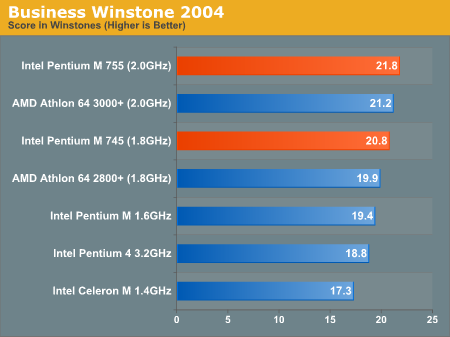
Business applications are one area where Banias originally dominated. If we look at our Pentium M 1.6GHz scores, we see that in business applications, Banias is actually slightly faster than a 3.2GHz Pentium 4. Looking at Dothan, we have performance that's competitive with an Athlon 64 3000+.
What's very important to note about the Dothan vs. Athlon 64 comparison is that at the same clock speeds, Dothan is able to equal and even slightly outperform AMD's offering - and this is without an on-die memory controller, and at lower power consumption.
It's clear that as a general usage mobile CPU, the Pentium M 755 can truly bring desktop class performance on the go.
Let's see how well it stands up when we throw some more content creation applications into the mix using Multimedia Content Creation Winstone 2004.
Multimedia Content Creation Winstone 2004 tests the following applications in various usage scenarios:
- Adobe® Photoshop® 7.0.1
- Adobe® Premiere® 6.50
- Macromedia® Director MX 9.0
- Macromedia® Dreamweaver MX 6.1
- Microsoft® Windows MediaTM Encoder 9 Version 9.00.00.2980
- NewTek's LightWave® 3D 7.5b
- SteinbergTM WaveLabTM 4.0f
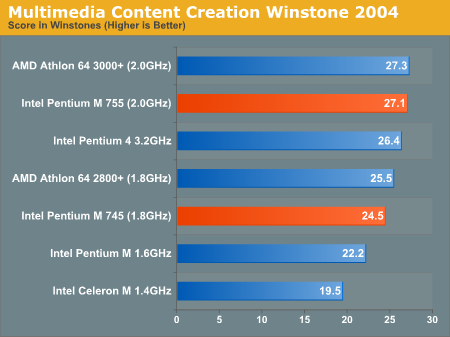
Here, the Pentium 4 does a lot better and the Athlon 64 manages to creep back up to the top of the charts, but the Pentium M still hangs in there, offering performance basically on par with the Athlon 64 3000+ and still faster than the Pentium 4 3.2GHz.
General Usage Performance - SYSMark 2004
Like the Winstone tests, SYSMark is an important suite to look at as this is how most users will use their notebooks. Just like Winstone, SYSMark is divided into both office and content creation suites; let's have a look.This time, we look at content creation performance first. Here's what happens with the Internet Content Creation suite:
"In this scenario, the content creator creates a product-related website targeting a broadband and narrowband audience. The user first renders a 3D model to a bitmap, while preparing web pages using a web site publishing tool. The user opens a video editing package, creates a movie from several raw input movie cuts and sound cuts and starts exporting it. While waiting on this operation, the user imports the rendered image into an image-processing package, modifies it and saves the results. Back in the 3D modeling software, the user modifies a 3D model and exports it to a vector-graphics format. Once the movie is assembled, the user edits it and creates special effects using one of the modified images as input. The user extracts content from an archive. Meanwhile, he uses an animation creation tool to open the exported 3D vector graphics file. He modifies it by including other pictures and optimizes it for faster animation. The final movie with the special effects is then compressed in a format that can be broadcast over broadband Internet. The web site is given the final touches and the system is scanned for viruses."
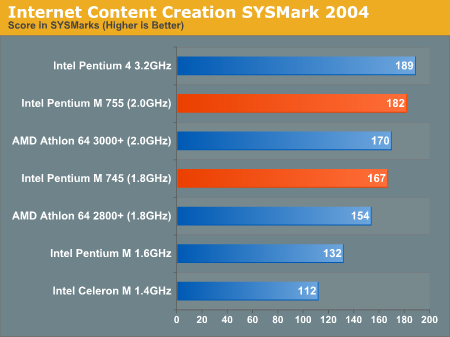
ICC SYSMark 2004 has always favored Intel processors; more specifically, the Pentium 4. Under the older SYSMark 2002 benchmark, this was the only test where the Pentium M could not hang with its older brother. This time around, we see that the Banias based Pentium M doesn't fair well at all, but with a few architectural tweaks, twice the cache and a higher clock speed, the Pentium M 755 is nipping at the heels of the Pentium 4.
The Pentium M also manages to outperform the Athlon 64, but that is to be expected here; once again, SYSMark has always favored Intel processors.
Next, we have the Office Productivity suite:
"In this scenario, the office productivity user creates a marketing presentation and supporting documents for a new product. The user receives email containing a collection of documents in a compressed file. The user reviews his email and updates his calendar while a virus checking software scans the system. The corporate web site is viewed and the user begins creating the collateral documents. The user also accesses a database and runs some queries. A collection of documents are compressed. The queries' results are imported into a spreadsheet and used to generate graphical charts. The user then transcribes a document. Once the document has all the necessary pieces in place, the user changes it into a portable format for easy and secure distribution. The user edits and adds elements to a slide show template. Finally, the user looks at the results of his work (both the slide show and the portable document) in an Internet browser. "
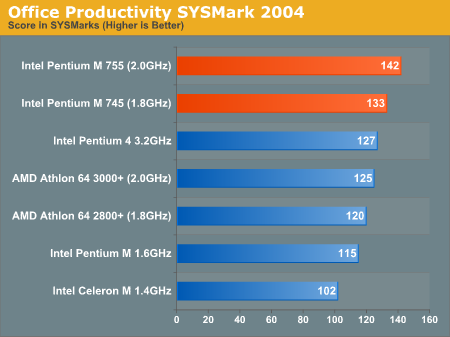
Here, the Dothan based Pentium M 755 manages to outperform the Pentium 4 3.2 and the Athlon 64 3000+, both by a significant margin. Further echoing our results from Winstone, it's clear that for business users, the new Pentium M is the king of the hill when it comes to mobile computing.
The overall SYSMark graph takes both ICC and Office Productivity performance into account. For reference, we show it below:

DivX and XviD Encoding Performance
Now, as we step out of the applications that the Pentium M was designed to run and into the realm of media encoding, we see how well Dothan stacks up against the kings of the desktop world.For our DivX and XviD encoding tests, we used AutoGK (a front end for DVD2AVI) and DivX 5.1.1 as well as the latest XviD release. We converted Chapter 11 of "Pirates of the Caribbean" using 75% quality as the target file size in AutoGK. We decoded audio and the rest of the settings were left as defaults. Results were reported in frames per second, higher numbers meaning better performance.
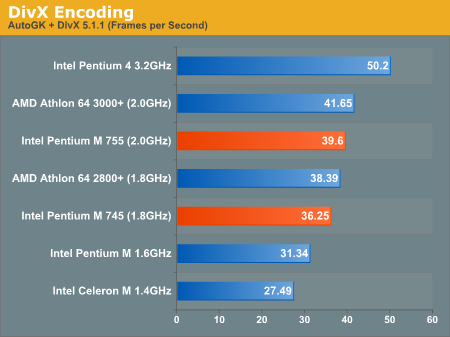
As usual, the Pentium 4 dominates the DivX encoding charts, outperforming the Pentium M by more than 26%. The Pentium M 755 is close to the Athlon 64 3000+, which is still impressive, but it's clear that the Pentium M's dominance does not extend into the realm of media encoding.
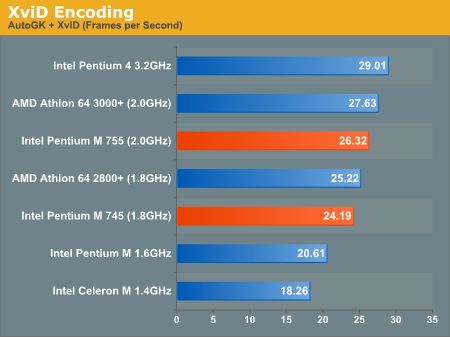
XviD encoding performance is pretty similar, with the performance differences shrinking considerably.
Gaming Performance
Mobile gaming is still nowhere near as popular as desktop gaming, but thanks to the efforts of ATI and NVIDIA, it is finally possible.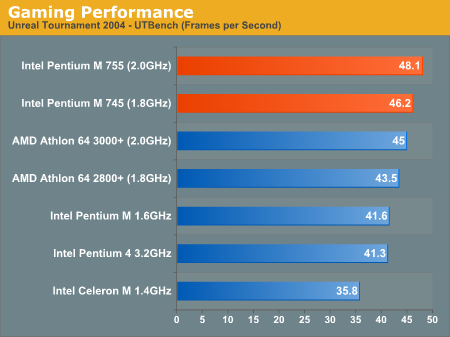
Under UT2004, the Pentium M manages to outperform the rest of the chips, delivering the highest frame rates. But, keep in mind that even at the low 800x600 resolution we were testing at, the game was still mostly GPU limited by the mobility Radeon 9600.
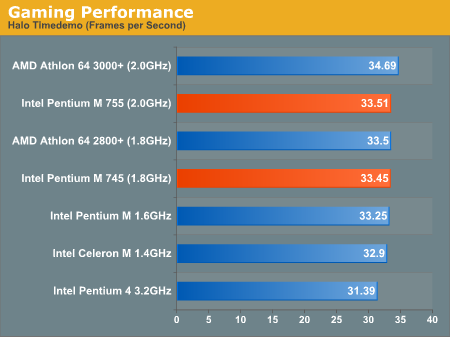
The performance under Halo, even at 800x600, is mostly GPU limited and thus we see the Athlon 64 3000+ at the top with most of the other contenders.
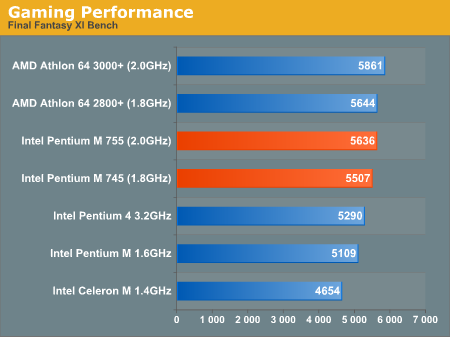
Under Final Fantasy, the Pentium M takes a backseat to only the Athlon 64. Clock for clock, the Athlon 64 does come out ahead by a negligible 4%.
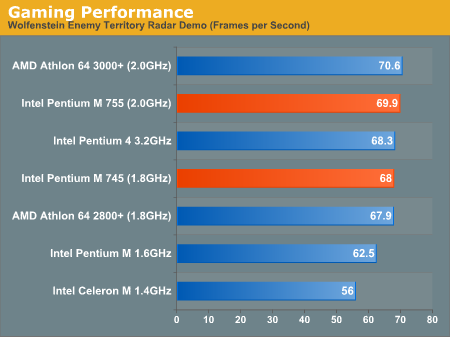
Here, we have yet another close call, thanks to GPU limitations. Really, only the Pentium M 1.6 and Celeron M 1.4 perform poorly here.
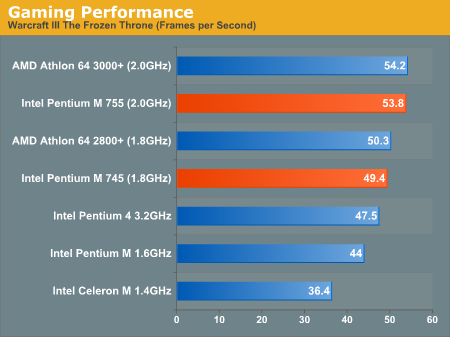
Under Warcraft III, thanks to Blizzard's excellent work at reducing GPU requirements while still making a beautiful game, we finally see some differences between the chips. The Athlon 64 3000+ and Pentium M 755 once again battle it out at the top; and even the Pentium M 745 doesn't mind giving the Pentium 4 3.2 a run for its money.
It would be nice to see what the Pentium M could really do without being held back by a mobile GPU. Unfortunately, there are no decent Pentium M motherboards with an AGP slot that were readily available at the time of this review. Needless to say, the Pentium M can hang with the best of them when it comes to mobile gaming.
Workstation Performance
Although it's clear that the Pentium M isn't a workstation CPU, we wanted to see how well it stacked up to the competition in some of our workstation tests.First up is our Visual Studio compile test, where we compile the Quake 3 source code and report compile time in seconds.
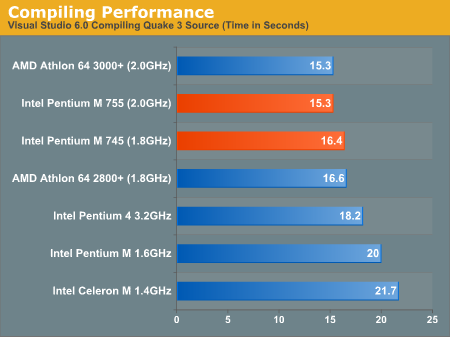
Shorter pipelined, higher IPC designs do much better when it comes to compiler performance and thus, we see that the Athlon 64 and Pentium M 755 tie for the lead at the top of the charts.
Those of you who do software development on your laptops may want to consider the Pentium M 755, but remember that another major performance factor here would be disk performance, so make sure that you get a fast drive with your notebook as well.
Next up, we have 3D rendering performance in 3dsmax:
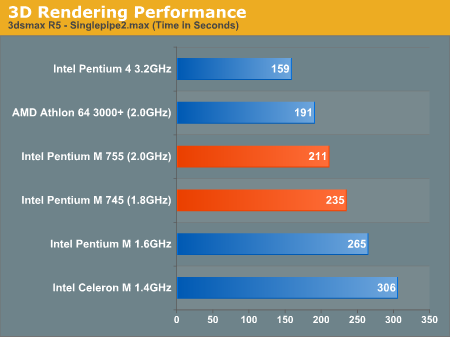
Here, the Pentium M takes a serious backseat to the Pentium 4 3.2. The Athlon 64 3000+ also outperforms the Pentium M in this test.
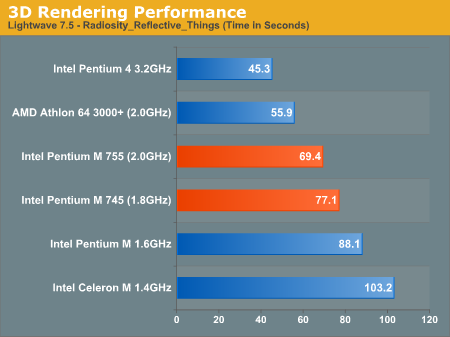
Under Lightwave, the performance results are similar. The Pentium M just isn't cut out for 3D rendering applications as much as the Pentium 4 and Athlon 64 are.
Final Words
Banias was revolutionary; it changed the shape of the mobile CPU world and it changed how we perceive mobile chip design to be pursued. It would be nice if the same mobile-oriented design methodology spread to companies like ATI and NVIDIA. Maybe then we would truly be able to game while on the go.Dothan, as an update to Banias, leverages Intel's 90nm process and some architecture tweaks to not stun us, but to keep us happy with the Pentium M platform. At 2.0GHz, the Pentium M 755 is easily the best chip that money can buy for a notebook. Clock for clock, it's faster and uses less power than Banias - there's really no reason not to like it.
If you're using your notebook for office applications and even for content creation applications, there's no beating the new Pentium M. Even developers will find short compile times, competitive with that of a similarly clocked Athlon 64, possible with the Pentium M at lower power usage as well.
What the Pentium M isn't, however, is as strong of a media encoding or workstation processor as either the Athlon 64 or Pentium 4. Partially constrained by its 400MHz FSB and single channel memory interface, the Pentium M is not the successor to the Pentium 4 that many will make it out to be. In many ways, the Pentium M is much like Intel's version of the Athlon 64, sans memory controller. The short pipelined design and accurate branch predictor give the Pentium M a nice and high IPC, similar to the Athlon 64, which give it strength in areas like business applications and are also responsible for its high performance in our compile tests.
With Intel's vision for the future being centered on media encoding and content creation, the Pentium M is the last thing that Intel would want to build their future desktop CPUs around. That being said, the Pentium M is quite possibly the best solution that Intel has for the office PC. It would be nice if Intel used the Pentium M as the basis for its desktop Celeron processor, instead of just a castrated Pentium 4.
The Pentium M will continue to be an excellent mobile chip, and the next incarnation of the Pentium M should be yet another revolution as it may even receive multiple cores as a part of Intel's overall threading strategy.
On the desktop, we may see features like micro ops fusion and some of the Pentium M's power saving technologies make their way into the Pentium 4's eventual successor. Dropping Prescott and moving towards Dothan would be a step back, using each architecture for their strengths and borrowing technologies for use in another would make much more sense for the future of Intel's microprocessors.
In the more short term, we may see some motherboard manufacturers make Pentium M based motherboards for desktop usage. Shuttle, in particular, is currently working on a small form factor box based on the Pentium M. That should be out by the end of this year.







